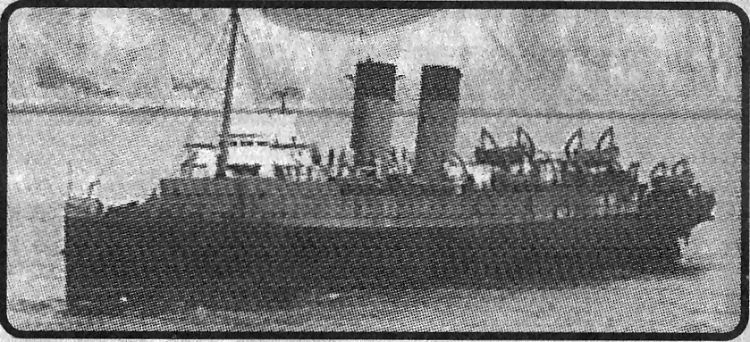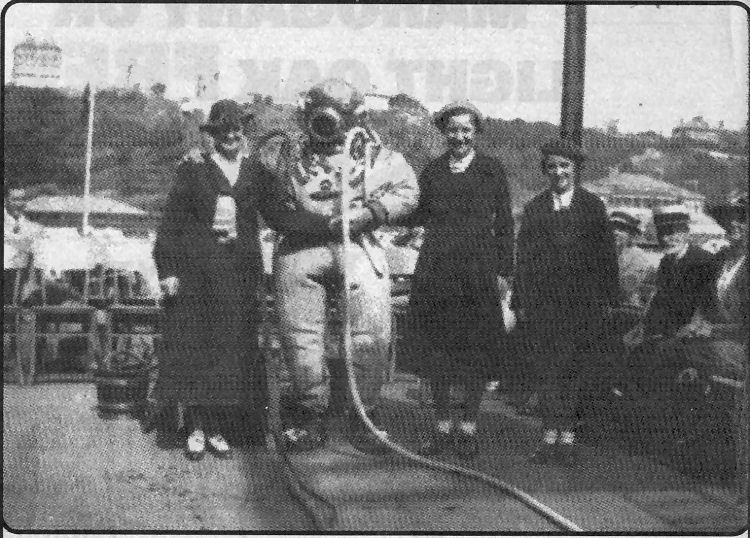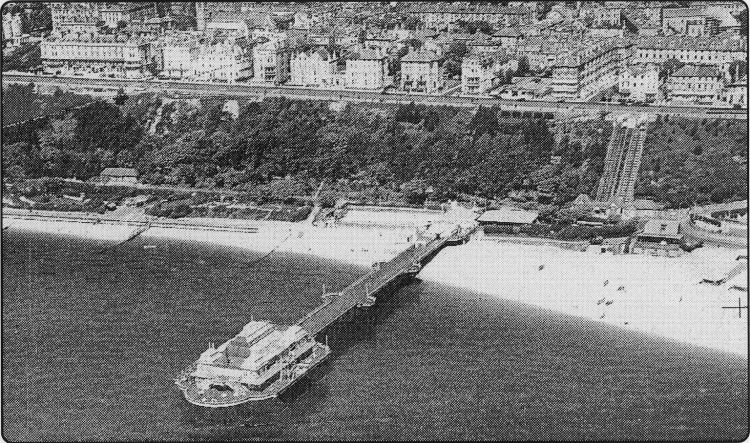
Published 21 February 2002

Attractions
MIKE Dugdale, of Saltwood, sent me this interesting picture by e-mail of a
diver, in full diving suit complete with massive brass helmet, who used to
be a popular tourist attraction giving demonstrations from the old Victoria
Pier in Folkestone, back in the 1930s.
In the background the Leas lift can be seen in the original picture.
Pictured with the driver are Mike's mother Betty (n6e Aguilar) and her
sister Denise, who lives in France.
"Mother's family lived in Lille, northern France and would come over to
Folkestone for their holidays. They were one section of a handful of
travellers who would bring their car over the Channel, the car being lifted
onto and off the decks of the
A DIVER, in full diving suit with brass helmet, was a popular tourist
attraction in Folkestone between the two World Wars, giving demonstrations
from the old Victoria Pier. I remember writing about this in Memories some
time ago, having read an account of how he used to dive from one side of the
pier and surface on the other, perhaps amusing onlookers by retrieving
something dropped over the side.
The second picture, left is an aerial view of a section of the seafront at
Folkestone showing the Victoria Pier and Pavilion which was such a major
asset for many years leading up to the Second World War. It was demolished
following a disastrous fire after the war. The photograph was shown to me by
graphic artist and art teacher Patricia Wren, of Glebe Studio, Lydd. The
other picture, top, is of the old Southern Railway cross-Channel steamer
Biarritz referred to this week in the From Our Files feature below, for
1927. In this picture it is on its way to be broken up at Dover.
cross-Channel steamers by means of cranes.
"My mother fondly recalls the elegant Leas, the Zig-Zag path, lit with
lanterns at night, and the smart Marine Parade of those days!
"Mother, who was brought up in France, would have had no idea then the war
was to make the family move from France to Devon and my mother to marry an
Englishman, Douglas Dugdale and persuade him to settle in Folkestone in the
early fifties. They had two sons, myself and Peter. Father ran his own
business until he died just over 10 years ago."
Mike says his father was one of the last soldiers to be lifted from the
beaches during the evacuation of Dunkirk early in the Second World War.
"My mother lives where she has done for over 40 years, in Wear Bay Road,
overlooking the Channel towards France."


 |
«| AArt “IT IS through such stupid people as '■JL+rVmmyou that smallpox
is so greatly on the Increase all over the country,” solicitor Mr
Wightwlck, In court, told a parent seeking a certificate of exemption
from vaccination which, he believed, was preiuditialio his child. But
the court granted the man his certificate. A white-haired veteran, one
of a band of ringers who rang out the bells of St Leonard’s Church,
Hythe, in honour of Queen Victoria's coronation, was among Hytbe and
Folkestone enthusiasts of all ages who attended a local bell ringers’
dinner at the Mechanics Arms. Herald writer Feifx wrote enthusiastically
about the great deal of voluntary, and very physical effort that went
into ringing. A Herald editorial enthused about the prosperous future
which seemed iikeiy lor Measure Gardens (theatre) Company,
that had got vff to a shaky start, some believing It a venture ahead
SMlft time. Hie editor referred to a phenomenally successful 4991, the
company paying out a dividend of 7.5% to siiarehoWetfc. Nevertheless the
depressed state of the cotwta' meant that it bad not been prudent to
press aheaS' with a £30,OOQnewtheatre and winter gardens.
|
Link witt brick-making of the past demolished
<i QEO AROUND 170 local people supported a wfc local appeal In aid of
victims of recent storm damage at Sandgate. A well known local landmark,
the “Brickfields” of Elham disappeared as a bulldozer went to work
clearing an area known as the “backs” so that the ground could be
ploughed. The brick kilns had been only a pile of nibble for many years,
workings having been suspended prior to the First World War. The
brickfields were established in 1885 and back in 1952 Jack Wiles, 81, of
the Old Row, Sham, could recaH working there as a youth. The “backs,”
seven In number, were large square hollows into which clay and water
deposits were once pumped from what was described as an old wash mill at
Exted, via a long pipeline across one and half mites of countryside, for
brickmaking- Former mines manager for the firm Stewart & Uoyd Ltd’s iron
and steel works, Mr W. Dixon 84, and his wife celebrated their Diamond
Wedding in Folkestone. They had moved to the town to live with their
youngest daughter and on-in-iaw Squadron Leader P.E. Bond, of Wear Bay
Road, Mr Dixon’s company made the steel tubes for the “Pluto” under-sea
fuel pipeline from Oungeness which carried petrol to the Allied Forces
in Normandy In the Second World War.
|
Folkestone-bound steamer
1007 WAS so thick in the Channel one Friday
I in February that the Southern Railway ferry Biarritz was forced to
stop over in Boulogne harbour overnight, it eventually reached
Folkestone Just after six the next morning —. nearly 12 hours late -
with 83 passengers aboard. This delay led to the birth on board of a
bonny baby. Proud mother was Mrs FA. Santhia, the wife of an official at
the British Embassy in Paris, who gave birth to a boy in the steward’s
cabin. She had planned to fly to England for the birth but the aircraft
was fog bound too. No doctor was on board but a Boulogne medical man
went out to the vessel. The Herald carried a pictureefttw baby with the
matron of the Eaton Court Nursing Home in Shomciiffe Road, Folkestone.
The local licensing session In the magistrates court heard that there
had been no increase in drunkenness In the district since an extension
of hours granted to public houses in the summer months following years
of campaigning by local licensees. The successful Folkestone & District
Motorcycle dub, whose membership included car owners, decided to back
members' pleas for more organised long-day social runs and |oj|ive a
"treat” for children of the local Cottars ftoniwVIn ths Jorm of-an
outing to the seaside.
|
for oil recovered from sea
H Q“**y SHIVERING shoppers queued outside JL«7 f f Debenhams in Sandgate
Road from as early as Sam for the start of sales and by 9am there were
200 of them, many amused by the fact that the previous day: some 100
Belgian visitors had turned up, complete with big shopping trolleys, a
day too early. They had planned a massive ‘spend-up’ because many
British goods, particularly clothes and food, were cheaper here 25 years
ago. Almost one in ten people was out of work in Folkestone and Hythe, a
total of nearly 2,000 jobless. A prompt start was due to be made on
£100,000 sea defence repairs made necessary due to damage and
destruction caused by a 2,000 ton runaway barge in recent gales. A
revolutionary method of dealing with a growing problem of oil slicks in
the Channel was due to be adopted In Folkestone. It was planned to use a
disused reservoir at Sandgate, on the Shomciiffe army camp site, capable
of bolding 166,000 gallons, to store oil recovered trysklmming the slick
off the surface qf the sea with a view to recycling it. Doubts over
whether the military authorities would foe agreeable, was one problem,
after news of the plan Inadvertently slipped out due to a clerical
error. Work began on building the new £700,000 law courts complex for
Shepway in Castle Hill Avenue, near the Civic Centre. The Nome Office
was expected to meet £560,000 of the cost. |
|




